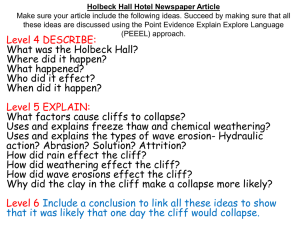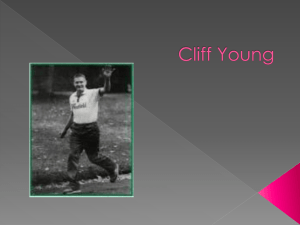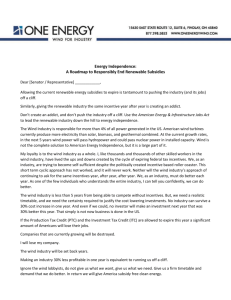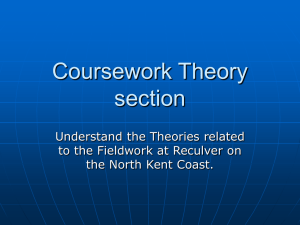GEL 101 (PHYSICAL GEOLOGY)
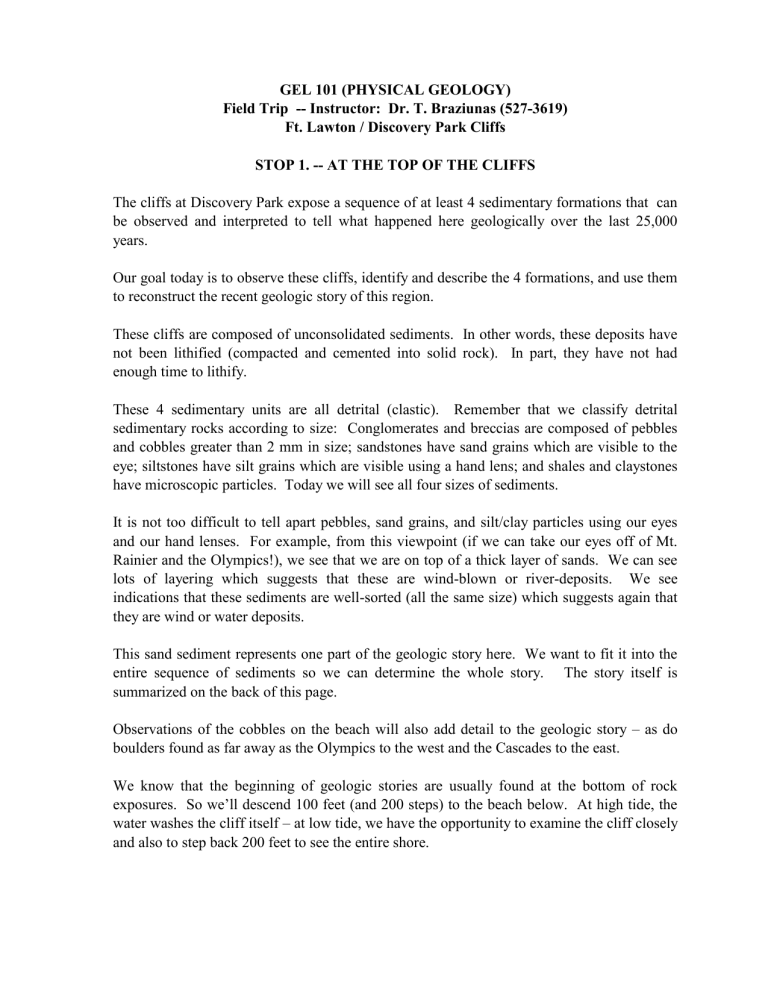
GEL 101 (PHYSICAL GEOLOGY)
Field Trip -- Instructor: Dr. T. Braziunas (527-3619)
Ft. Lawton / Discovery Park Cliffs
STOP 1. -- AT THE TOP OF THE CLIFFS
The cliffs at Discovery Park expose a sequence of at least 4 sedimentary formations that can be observed and interpreted to tell what happened here geologically over the last 25,000 years.
Our goal today is to observe these cliffs, identify and describe the 4 formations, and use them to reconstruct the recent geologic story of this region.
These cliffs are composed of unconsolidated sediments. In other words, these deposits have not been lithified (compacted and cemented into solid rock). In part, they have not had enough time to lithify.
These 4 sedimentary units are all detrital (clastic). Remember that we classify detrital sedimentary rocks according to size: Conglomerates and breccias are composed of pebbles and cobbles greater than 2 mm in size; sandstones have sand grains which are visible to the eye; siltstones have silt grains which are visible using a hand lens; and shales and claystones have microscopic particles. Today we will see all four sizes of sediments.
It is not too difficult to tell apart pebbles, sand grains, and silt/clay particles using our eyes and our hand lenses. For example, from this viewpoint (if we can take our eyes off of Mt.
Rainier and the Olympics!), we see that we are on top of a thick layer of sands. We can see lots of layering which suggests that these are wind-blown or river-deposits. We see indications that these sediments are well-sorted (all the same size) which suggests again that they are wind or water deposits.
This sand sediment represents one part of the geologic story here. We want to fit it into the entire sequence of sediments so we can determine the whole story. The story itself is summarized on the back of this page.
Observations of the cobbles on the beach will also add detail to the geologic story – as do boulders found as far away as the Olympics to the west and the Cascades to the east.
We know that the beginning of geologic stories are usually found at the bottom of rock exposures. So we’ll descend 100 feet (and 200 steps) to the beach below. At high tide, the water washes the cliff itself – at low tide, we have the opportunity to examine the cliff closely and also to step back 200 feet to see the entire shore.
GEL 101 (PHYSICAL GEOLOGY)
Field Trip -- Instructor: Dr. T. Braziunas (527-3619)
Ft. Lawton / Discovery Park Cliffs
STOP 2. – AT THE BOTTOM OF THE CLIFFS
STATION A. – SANDY CLIFF
Look for two sedimentary formations here. They are different in their sedimentary textures
(such as grain size, sorting and color) and structure (such as layering).
1. Find these two deposits and describe the sedimentary features of each of them (although you cannot actually walk up to the cliff itself). Describe what you can determine about their layering, sorting, grain size, and color.
2. Are these sedimentary units distinct or does one grade into the other? Sketch in the approximate contact line between these two formation on the profile shown on the back of this page. About how thick is each formation at this place?
3. With what you know about the relationship of grain size to energy of depositional environments, which one of these formations would have been deposited in a “higher energy” environment? Why?
4. With what you know about sorting, which of these formations might have been deposited by rivers or wind? By glaciers? Why?
5. Given the sequence of formations and the Law of Superposition, which formation was deposited first? Which would be youngest?
6. Putting this together with what we know from the observations in the above questions, what does this tell us about what happened here?
GEL 101 (PHYSICAL GEOLOGY)
Field Trip -- Instructor: Dr. T. Braziunas (527-3619)
Ft. Lawton / Discovery Park Cliffs
STATION B. – BULGE IN THE CLIFF
Proceed to the prominent bulge in the cliff. You will find two very different formations here than at Station A. Unlike at Station A, you will be able to touch and examine closely at least the bottom-most formation.
7. Describe what you can determine about the lower formation (layering, sorting, grain size, and color). How thick are these various layers? The difference between silt and clay is difficult to determine. Try your hand lens. Also, for the brave geologists, one distinction is that, although silt and clay both feel relatively smooth, silt tastes gritty while clay tastes smooth! Yum.
8. Notice the color differences in the layers of this formation. Notice also that some layers more prominently stick out than others. What are these color differences and where do you think they come from? Why do some layers stick out more than others? Is there a relationship between this feature and the color? Could there be a connection?
9. Fossils are found in the lower formation. There may be plant matter or tiny fresh-water critters visible in this layer. Look closely and report any suspected organic remains that you find. It is sometimes hard to tell what is embedded in the sediment at the time that it formed and what has become attached to the sediment more recently. See if you can tell.
10. Is this a high-energy or low-energy deposit? Why? Examples of low-energy environments are lakes and river flood-plains. Often sediments on flood-plains are exposed longer and can become oxidized. What type of environment might we have here?
11. Can you see evidence of where waters from high tide reach this cliff? What is the evidence and how high on the cliff is the high tide mark?
12. Sketch in the contact between this unit and the one above – as accurately as you can from what you can observe here.
GEL 101 (PHYSICAL GEOLOGY)
Field Trip -- Instructor: Dr. T. Braziunas (527-3619)
Ft. Lawton / Discovery Park Cliffs
STATION C. – JUST SOUTH OF THE BULGE
Past the bulge in the cliff you will be able to sample the fourth different formation -- which is the one above the one you just described. Notice the slide debris from this formation. When you sample the sediment, try to find a piece that is relatively intact. You can’t really get right up to the cliff because the slide debris covers the bottom of it.
13. How do we know that this unit is above the previous one at the bulge? Look at the cliff and follow the layering of these units. Sketch in the contact between these two formations as best you can. Do you agree that we are now looking at a formation above the previous one?
Why?
14. In what direction does the upper unit dip? About how much does it appear to dip?
15. How does this formation differ in structure from the previous one? Is it different in layering, jointing (vertical cracks), and color? How?
16. Pick up a piece of this formation from near the cliff. Use your hand lens (and maybe the taste test). How does it differ in grain size from the previous formation? How do you know it is a different grain size?
17. Is this a high-energy or low-energy deposit? Why? Examples of low-energy environments are lakes and river flood-plains. Often lake sediments form thick (massive) layers from quiet, continuous settling of fine sediment in a very uniform, unchanging environment. Is this the type of environment we might have here? Why?
18. Put together a story between these two formations. What environments do they represent? Which came first? What material could be dated to give us an absolute age for this story? What radiometric method of dating would we need to use?
GEL 101 (PHYSICAL GEOLOGY)
Field Trip -- Instructor: Dr. T. Braziunas (527-3619)
Ft. Lawton / Discovery Park Cliffs
STATION D. – THE HIGH CLIFF
Proceed to a spot way out near the water line where you can see the highest exposure of the cliff. Now we can see the formation which rests on top of the one we just described. In fact this is the formation we were standing on during Stop 1. It is also the formation which we saw at Station A.
19. Step way back from the cliff. How would you describe the sedimentary formation now visible in the upper part of the cliff? Sketch in the contact as best as you can determine between it and the formation below.
20. We seem to have a problem! At Station A, this formation was at the bottom of the cliff whereas here it is at the top of the cliff. To try to resolve this problem, step way, way back from the cliff (at least 200 feet back!). Put together the four pieces of the profile you have worked on. Find a distinctive sedimentary layer which you can follow and sketch it onto your whole profile – that is, try to follow it from Station to the others. Do this with other layers so we can get an overall picture of how the pieces of the story fit on top of one another.
Station A does not fit in with the rest of the cliff.
21. It appears that the cliff at Station A has slumped. These formations belong above the ones we studied at the other stations. This part of the cliff with its younger sediments has slumped down from above so that it is now the same level as much older deposits. How can we tell? Look at the vegetation – are the trees at Station A younger than the trees at the other stations? Could the absence of older trees be evidence that it slumped? How old do you think the oldest trees are here on the cliffs?
22. We could look to see if we can confirm that the cliff at Station A is not part of the continuous sequence of formations we see at the other stations. Can we find a clear contact point between the cliff at Station A and the rest of the cliff? Yes or no? Why or why not?
GEL 101 (PHYSICAL GEOLOGY)
Field Trip -- Instructor: Dr. T. Braziunas (527-3619)
Ft. Lawton / Discovery Park Cliffs
THE BIG PICTURE
23. Let’s accept that the two formations at Station A are on top of the two other formations we have described (in an undisturbed sequence). Put together a story for this cliff. We have evidence of four different depositional environments. We know which came first, second, etc. Look at the story on the back of your Stop 1 handout. Relate the four formations we have seen to this story. Which formations belong to which part of the story? Why?
GEL 101 (PHYSICAL GEOLOGY)
Field Trip -- Instructor: Dr. T. Braziunas (527-3619)
Ft. Lawton / Discovery Park Cliffs
THE BEACH
The beach itself has many interesting features which can help us even further to put together a complete story for this region.
24. Take a look at the features we find on this beach. Let’s say this beach were buried by a sudden collapse of the cliff or perhaps by a violent storm which swept in a thick layer of sediment. The features of this beach would remain intact but buried safely under a quickly deposited layer of sand. What sedimentary structures (caused by wave action) would tell us that this has been a shoreline? What types of fossil evidence would we find (what type of plant and animal remains might be preserved)? Trace fossils are features that show the
“activity of organisms” but not the organisms themselves. Do you see any potential trace fossils on the beach?
25. Notice the cobbles on the beach near the cliff. Many of these cobbles have come from the cliffs. Would it make sense if we found out that many of the cobbles we find are chunks of rock that belong to rock formations in Canada? Why?
26. Pick up five different cobbles and try to identify what rocks they came from. Do you think they are igneous, sedimentary or metamorphic? Why?
We haven’t discussed why we have the prominent terrace between the upper and lower cliff.
This is an important feature which ties into the hazards of building on these cliffs. The last handout shows how such terraces form.
